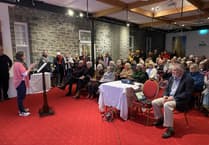COMPLETED in the summer of 1990, Roadford Lake remains the largest reservoir in the South West. The reservoir, situated between Okehampton and Launceston, plays a vital role in South West Water's regional water supply strategy, holding an enormous net storage of 34,500 megalitres.
It is one of three major reservoirs in the region, with the others being Wimbleball on Exmoor and Colliford on Bodmin Moor. The completion of these three lakes was part of a strategy by South West Water to quadruple its water supply and storage capacity from its 1974 level. The Roadford site was selected in 1975 from a shortlist of four locations – the others were at Swincombe, Bickleigh and Townleigh. More than 100 possible sites were initially investigated before the shortlist was compiled.
The first of three lengthy public inquiries took place in 1978 and these inquiries meant work did not start on Roadford until the 1980s. Permission was given for Roadford in 1983 but only two-thirds the size of the original proposal. The drought of 1984, however, led to that decision being changed to allow Roadford to be its originally intended size.
In 1984 a trial quarry was dug and trial embankment tests were carried out. During test drilling, more than four kilometres of core samples were taken.
After several years of consultation, work on the dam began in early 1987. In the 18 month period before the flooding of the valley began, the land was cleared of hedges and trees, each part of the work being phased to ensure the natural habitats of animals and birds were disturbed at least critical times. Nesting boxes were provided for bats, owls and other birds and special provision was made for otters, badgers and dormice. Wild flowers and shrubs were moved and replanted, and 150,000 trees and shrubs planted around the lake.
The first water flowed into Roadford Lake in October 1989 and boosted supplies during the summer of 1990. The lake was created by building a dam across the River Wolf. The dam, which stands at 430 metres long and 40.5 metres high, was constructed of rock taken from a quarry within the reservoir basin just 500 metres upstream. An asphalt membrane covering the dam's upstream face keeps it watertight and an inspection gallery was built into the toe of the dam.
The two concrete structures visible above the water are the valve tower and the bellmouth overflow. The valve tower enables water from the reservoir to be drawn off and taken to a pump house downstream of the dam. The bellmouth spillway acts exactly like an overflow to a sink. When the reservoir is full, the excess water flows over and safely down to a culvert beneath the dam and on to the river downstream.
During the summer, large deep lakes like Roadford tend to stratify – forming layers of poor quality water and low oxygen levels in the lower depths. To combat this, de-stratification is carried out. Air is blown through perforated pipes which stretch out from the dam, bubbling up to make sure the water is oxygenated right through its depth. Water quality is continually monitored at different depths and regular samples taken for full analysis.
As well as providing water for large parts of Devon, the lake is now a well-established leisure facility. A visitor centre on the lake's southern bank gives information on the history of the valley with interactive exhibits.
Rosie Vine, a spokesperson for South West Lakes Trust, told the Times:?'Roadford receives around 250,000 visitors annually. Many take part in informal activities such as walking, cycling and bird watching or simply relaxing in the Lakeside Café, enjoying a homemade lunch or traditional cream tea. Others get outdoor and active, learning a new sport such as sailing, canoeing or windsurfing, while game anglers fish for brown trout in the majestic 740 acre lake.
'Roadford lake has a good variety of habitats, which are home to a very broad range of flora and fauna. The otters and dormice are very elusive, but you may catch a glimpse of the rare Marsh Fritillary butterfly on a warm sunny day. Later in the year Roadford is a very important place for winter visiting birds.'
There are many miles of paths following the shorelines of the lake and meandering through woodland. There's also a wealth of wildlife to watch and discover. Cycle trails provide a safe, off-road family route taking in views of the lake and wildlife. The Coombe park walk has a cob shelter and bird hide.
There is also a popular outdoor activity centre. Roadford Lake is the largest lake for watersports in the South West offering sailing, windsurfing, kayaking, multi-activity days, climbing, high rope course and archery. For the more sedate pastime, people can climb into an angling boat and try their hand at fly fishing.
Roadford is also the home of a striking, six metre, stainless steel sundial, which was Devon's gift to Queen Elizabeth II to commemorate her Diamond Jubilee. The six stainless steel pieces represent the six decades of Her Majesty's reign and are surrounded by granite time pieces.
n To find out more about Roadford Lake, visit the website at http://www.swlakestrust.org.uk/lakes-and-facilities/the-lakes/roadford-lake">www.swlakestrust.org.uk/lakes-and-facilities/the-lakes/roadford-lake



